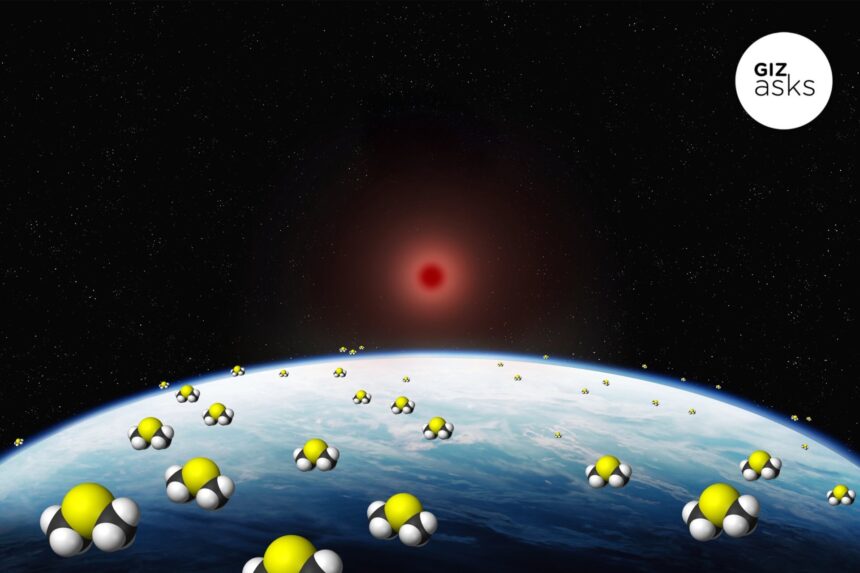Last week, researchers using the James Webb Space Telescope (JWST) announced they had found something intriguing on a distant exoplanet called K2-18 b: a potential whiff of dimethyl sulfide (DMS), a molecule that, on Earth, is produced almost exclusively by microscopic marine life. The exoplanet, located about 120 light-years away, orbits within the habitable zone of a red dwarf star and may be a Hycean world: a steamy, ocean-covered planet with a hydrogen-rich atmosphere.
While the detection came with a statistical confidence of 3-sigma (very promising, but not definitive), headlines around the world buzzed with speculation about the first detection of life beyond Earth. But not everyone’s convinced. Scientists across disciplines are now weighing in—some are cautiously optimistic about the latest research, while others are deeply skeptical. Could DMS be a sign of life, or is it just weird, abiotic chemistry happening under extreme conditions?
For this latest Giz Asks, we’ve rounded up expert reactions to the findings, digging into the chemistry, the data’s limitations, and what it’ll take to move the needle from “maybe” to something more conclusive. Because in astrobiology, the line between interesting and extraordinary is razor thin. The following responses were lightly edited and condensed for clarity.
Oliver Shorttle
A planetary chemist at the University of Cambridge who studies the potential habitability of planets, among other things.
I have worked on developing an understanding of the climate and structure (i.e., the size and temperature of the atmosphere, what underlies the atmosphere etc.) of K2-18 b.
I do not believe the report of DMS in the spectrum of K2-18 b moves the astrobiological needle. The series of steps to having confidence we have seen signs of life beyond Earth are roughly:
- Establish the signal is really of the planet being looked at (in this case, from absorption of light passing through the planet’s atmosphere)
- Establish the signal is attributable to the biosignature of interest (in this case, molecular absorption in the spectrum from DMS).
- Rule out non-biological processes as being able to produce the biosignature.
- Rule in (hypothetical) biological processes as being able to produce the biosignature.
The K2-18 b detection has not passed 1 or 2 yet—for that the community needs to confirm for themselves there is a signal. This is not my expertise.
3 and 4 are closer to my expertise. Here, K2-18 b presents a particular challenge to life. There is presently no requirement from the data that this planet hosts liquid water oceans and a climate amenable to life. In fact, based on the data there is every reason to believe the climate will be far too hot for liquid water oceans, with the deep atmosphere potentially being underlain by oceans of magma, not liquid water. For this reason, even if 1 and 2 return a DMS detection, our expectation should be that this [molecule] has emerged in a lifeless, hot, sulfur and hydrogen rich atmosphere and ask ourselves what the atmospheric chemistry is that would have enabled this. Believing instead that this is DMS of biological origin would require overturning our every expectation as to the climate of this planet, without any other reason to do this from the data.
In other words, we are a long way from believing K2-18 b can be inhabited, let alone is inhabited.
Christopher Glein
A geochemist at the Southwest Research Institute and an expert in researching the possibility of extraterrestrial life on ocean worlds.
This is a very interesting new dataset. It appears that there are unexplained features in the spectrum of K2-18 b, which could be attributed to dimethyl sulfide or dimethyl disulfide. However, these results are stretching JWST to its limits (K2-18 b is a fairly small planet), and it’s possible that further analysis may find a lack of statistically significant evidence for these features. We need more astronomers on this case as soon as possible! Currently, I’m intrigued but cautious about the potential presence of these molecules on K2-18 b.
Even if DMS or DMDS are present, we must be very careful in treating them as biosignatures. We’ve only just begun to ask questions about the abiotic background on this kind of planet. Exotic chemistry might surprise us, as planets are more complex (and wonderfully interesting) than we first assume. For life to be detected, multiple supporting pieces of evidence must be found, and this will take time. Let’s digest these new results and get to work.
My preprint includes an important finding quoted below:
“Because a revised deep-atmosphere scenario can accommodate depleted CO [carbon monoxide] and NH3 [ammonia] abundances, the apparent absence of these species should no longer be taken as evidence against this type of scenario for TOI-270 d [a planet orbiting another red dwarf, discovered in 2019] and similar planets, such as K2-18 b. Our results imply that the Hycean hypothesis is currently unnecessary to explain any data, although this does not preclude the existence of Hycean worlds.”
Nikku Madhusudhan
An astrophysicist at the University of Cambridge and lead author of the recent study.
The needle is somewhat more in the direction of potential life than before, but we need to remain very cautious and open to other possibilities.
I think what we should be most excited about is the fact that we have any data to begin with, to even discuss the possibilities. I think more data
over the next 1 to 2 years should provide better constraints.
Ignas Snellen
An astrophysicist at Leiden University and an expert on extrasolar planets.
The whole thing is completely blown out of proportions. Sorry that I am a bit short in my answers, but I have had to deal with this in the Dutch and Belgium media for the last two days, and I am a little done.
The research team finds bumps in their spectrum. It is not clear whether these are real, and if so, what they could be caused by. There could be dozens of molecules (if real), or even cloud features. What do the authors do? They just look whether DMS could cause this (and add DMDS). They ignore the dozens of other species [i.e. non-biological sources of molecules] that could cause this bump and call it a day. If I had been the referee, I would have stopped this publication right there. There is no reason to invoke astrobiology, let alone call it the biggest breakthrough or whatever.
Most reporters are writing a piece where they say something like “however, not all scientists are as convinced…” I can tell you, it is much worse than that, but most of us are keeping our mouths shut. I understand why, in these difficult times, but in the long run this will hurt astronomy when nobody will take us seriously anymore. You can quote me on that.
Sara Seager
A planetary scientist at MIT specializing in extrasolar planet atmospheres.
Because they likely can’t ever be confirmed either way, we have to live with what we might call “biosignature planet candidates.” This planet needs more work to get there. You can be sure that others are working on ways DMS can be produced without life.
I appreciate people’s enthusiasm. With more evidence, this and other planets might be “blessed” as biosignature candidates, but will remain in the candidate category indefinitely.
Read the full article here












